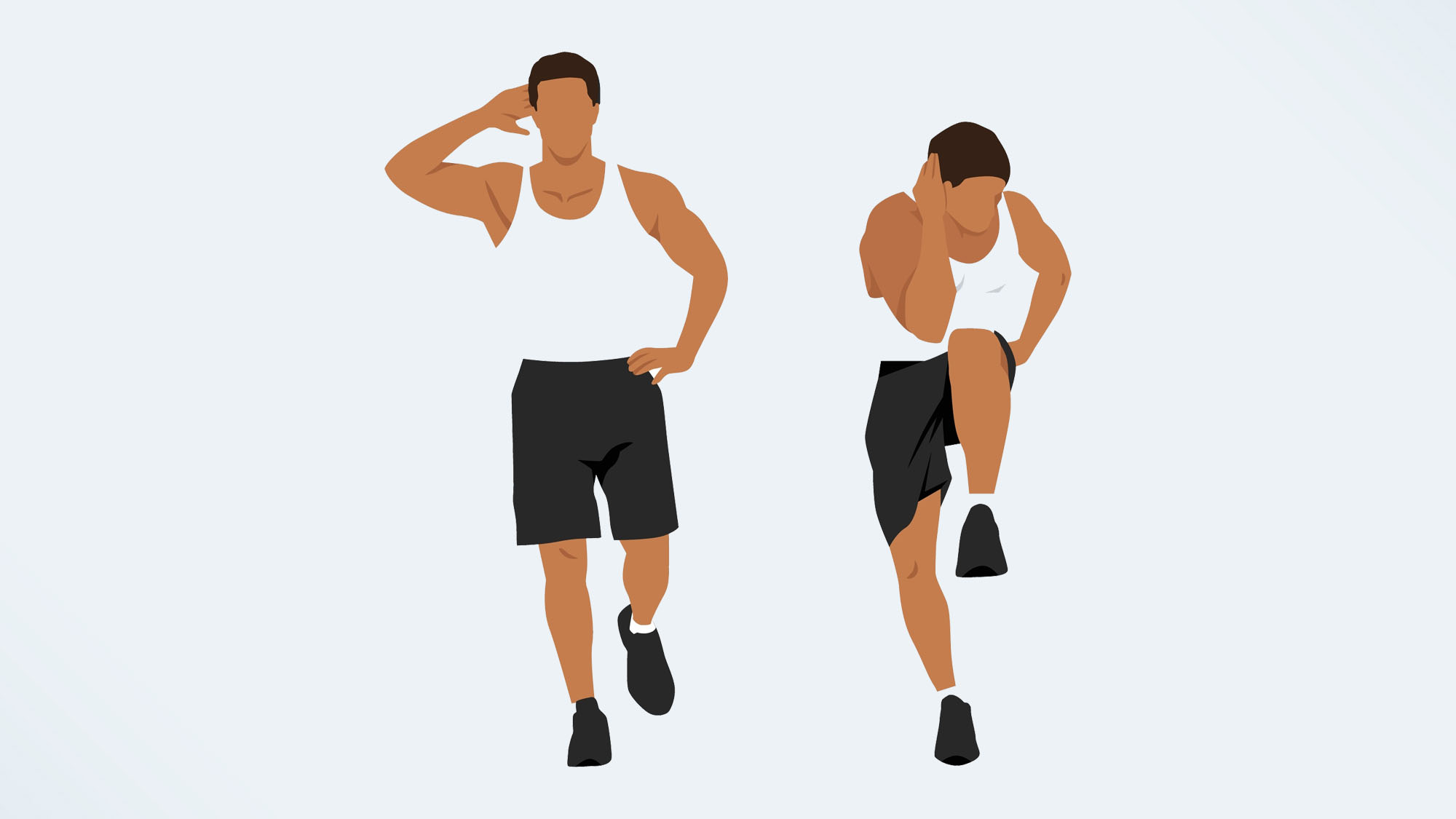I did the standing bicycle crunch for a week — here's what happened to my core
This variation on a familiar move takes the stress off your lower back

Before I did this challenge, I had never performed a single standing bicycle crunch (sometimes known as the standing cross crunch). In fact, I’d never even seen anyone do it, which probably should have told me something. I’d done the standard move, where you lie on your back, and found it an effective exercise for targeting the oblique core muscles, but the standing version had never occurred to me. So I was interested to see how useful it was.
What is the standing bicycle crunch?
This is a body-weight move that mimics the motion of the regular bicycle crunch, but from a standing position. It works the core muscles, with an emphasis on the obliques, which run along the side of your torso, from your ribs to your hip bones. These muscles help protect your spine and are used for rotational movements, as well as bending from side to side. They are also vital for overall trunk support, and, therefore, good posture. They even play a role in breathing.
Many people neglect their obliques in their core workouts purely because they don’t have the dramatic visual appeal of a six-pack. There’s also a school of thought that says working the obliques develops a bigger waist. This is not a good school.
How to do a standing bicycle crunch

- Begin in a tall standing position, feet hip-width apart.
- Bring your hands behind your head (but don’t lock your fingers), and draw your shoulder blades toward each other so that your elbows are facing directly out from the sides of your head and your upper arms are parallel to the floor.
- Contact your abs and raise your left knee while rotating your torso as you bring your right elbow down towards it. Try to touch your knee with your elbow, but don’t worry if you can’t right away.
- The focus should be on the core, so don’t angle the knee inwards and make sure you keep your elbows wide. Don’t pull your body down to meet the knee.
- Return to start position and repeat on the other side.
- Start off with 10 reps on each side and build from there.
I did the standing bicycle crunch for a week — here’s what happened
Day 1
While this may seem a relatively simple move, it’s an easy one to perform incorrectly and it’s even easier to cheat, so you may think you’re getting the full benefit when you’re really only performing an elaborate bow to an imaginary dignitary.
On the first day, I noticed the effort in my abs and also, surprisingly, in my glutes. That was the only time I noticed the move in those muscles, so I put that down to the fact they were caught by surprise. They were ready the next time. Because I was determined to introduce knee to elbow, I noticed a tendency to bend forward at the hips, drop my elbow, and allow my leg to swing in a little. This is all wrong. Never forget this is a core move.
I did three sets of 25 and some of them were correct.
Day 2-3
This was better, mostly because I forced myself to slow down. As with many of these dynamic body-weight exercises, momentum can deceive. Just because you’re in a groove of repetitive motion in a manner that resembles the move doesn’t mean you’re doing it properly. Be sure you come up to a standing position after each rep: Don’t crouch. I noticed that allowing my knee to drift inwards meant I could raise it higher, which, in turn, meant I didn’t have to work as hard to bring my elbow to touch it. This may feel right, but it’s poor form. I did three sets of 30.
Sign up to get the BEST of Tom's Guide direct to your inbox.
Get instant access to breaking news, the hottest reviews, great deals and helpful tips.
I did the same the following day, but I was feeling it more in my hip flexors than in my core, which told me I was still not doing the move properly. I decided to aim for the outside of my knee — or thereabouts — with my elbow, to give my oblique muscles more to do. I also dropped my knee slightly.
Day 4-5
On day 4, I did three sets of 40 and was beginning to feel frustrated with the move. I was feeling some tension in my core, but not enough. My hip flexors continued to bear the brunt, though I was doing the exercise smoothly and watching my form in a mirror.
With most of these challenges, I can feel the effort in the targeted muscles for some time afterward, often into the following day. Not this one. And, worse (so much worse), I was having to watch myself perform the move to ensure good form. It was like looking in a mirror while having your hair cut: After a while all you see are flaws and when your head is lowered and your chin tucked in, you raise your eyes and see the face of a rueful clown.
Day 6-7
I broke down the move into its components and focused on each aspect, doing it even slower than before. This time, I had no issues with my hip flexor muscles and felt my core muscles working properly. I did three sets of 40 and three of 50 on the final day, and finished the week feeling vaguely dissatisfied.
On the whole, this move didn’t win me over. I can see the point of it: As a core exercise, it puts less strain on the neck and lower back than the standard bicycle crunch, and it’s probably a good way to start work on those obliques if you are relatively new to a fitness regime. However, to target those muscles, I far prefer exercises such as the Russian twist, or the good old-fashioned side plank. Neither is especially onerous, but, for me, they’re far more satisfying than the standing bicycle crunch. Or just lie down and try the regular bicycle crunch.
More from Tom's Guide
John is a writer and editor based in London. He was worked for magazines such as Runner’s World, Men’s Health, Women’s Health and Cosmopolitan. A keen runner, what he lacks in ability he makes up for with enthusiasm and excuses.

